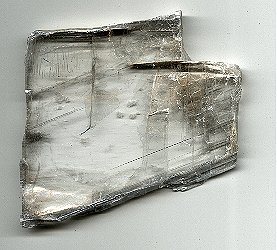Gypsum
Anhydrite - Selenite

| Chemical Formula: | CaSO4 |
| Color: | colorless, white, gray. |
| Diaphaniety: | Transparent to translucent |
| Hardness: | 2 |
| Density: | |
| Luster: | |
| Streak: | white |
| Crystal System: |
There is a rock which has the chemical formula CaSO4 and is commonly referred to by chemists as calcium sulphate. It is a rather strange substance which is able to store a certain amount of water. Unlike porous sandstone, however, the water is not in the pores, but the rock absorbs the water, changing its chemical formula and some physical properties in the process. The most important change is probably that its volume increases significantly and its specific weight decreases accordingly. The waterless rock is called anhydrite (Latin: ‘without water’), the water-containing gypsum.
Anhydrite is a sedimentary rock, which is usually formed by the evaporation of seawater in large depressions, especially in arid regions. In the process, alternating layers of gypsum and salt are formed. As the water evaporates, the limestone precipitates first, then the gypsum and finally the various salts such as common salt and potassium salt. This is known as an evaporite series, or simply a series: when fresh seawater enters the sink, the series starts all over again. In the end, there are many such series on top of each other. The gypsum which has been deposited is hydrous and therefore deserves to be called gypsum. During diagenesis, when the temperature rises, the water leaves the gypsum, and it is transformed into anhydrite. However, when this anhydrite comes close to the earth’s surface, for example, through erosion, and comes into contact with groundwater, it is converted back into gypsum through the absorption of water. This is why most people only know gypsum.
Gypsum is very rare on the earth’s surface. This is due to another property: gypsum is easily soluble in water. Common salt dissolves easily in water, with gypsum this happens a little more slowly, but it also dissolves without the need for other chemical substances. This is quite different from limestone, which is only dissolved by the carbon dioxide in the water. In other words, gypsum is generally dissolved underground before it reaches the earth’s surface. If it does reach the surface, it is usually karstified. Gypsum therefore has a significance as a karstifiable rock, and caves in gypsum are consequently called gypsum caves.
Speleothems, which consist of gypsum, are quite common. It is quite obvious that gypsum caves often contain gypsum speleothems. Gypsum is simply dissolved by the water, forming the cave, and when the water is supersaturated, the same gypsum is precipitated again as a crystal. Sometimes the caves are filled with groundwater for a very long time and huge selenite crystals form.
Other caves, for example in limestone, sometimes also contain a large amount of gypsum speleothems. The reasons for this are usually sulphur thermal springs in the caves and the chemical similarity of limestone and gypsum. The sulphur springs are the basis of life for sulphur-loving microorganisms that live in the fissures. These bacteria, which feed on sulphur, produce various substances such as sulphuric acid. This reaction promotes cave formation as it corrodes the rock. Limestone and calcite are converted into gypsum by adding sulphur. As a result, limestone caves can contain large quantities of gypsum minerals.
The typical gypsum mineral is selenite. It is often transparent and the crystals sometimes form large plates. These plates were once used for glass windows and display cabinets. In Germany, it was called Marienglas, as it was also used to cover small pictures of the Virgin Mary.
Gypsum speleothems can take on a wide variety of shapes, crystals that can become very long. The largest such crystals were discovered in a natural cave in a mine in Naica, Mexico. They were over 10 metres long and had a diameter of half a metre or a metre. There are also hair-like forms, large clusters of smaller crystals that look like crystal chandeliers and many other forms. The very white colour is typical.
 Evaporite - Wikipedia (visited: 07-NOV-2024)
Evaporite - Wikipedia (visited: 07-NOV-2024)
 Index
Index Topics
Topics Hierarchical
Hierarchical Countries
Countries Maps
Maps Search
Search